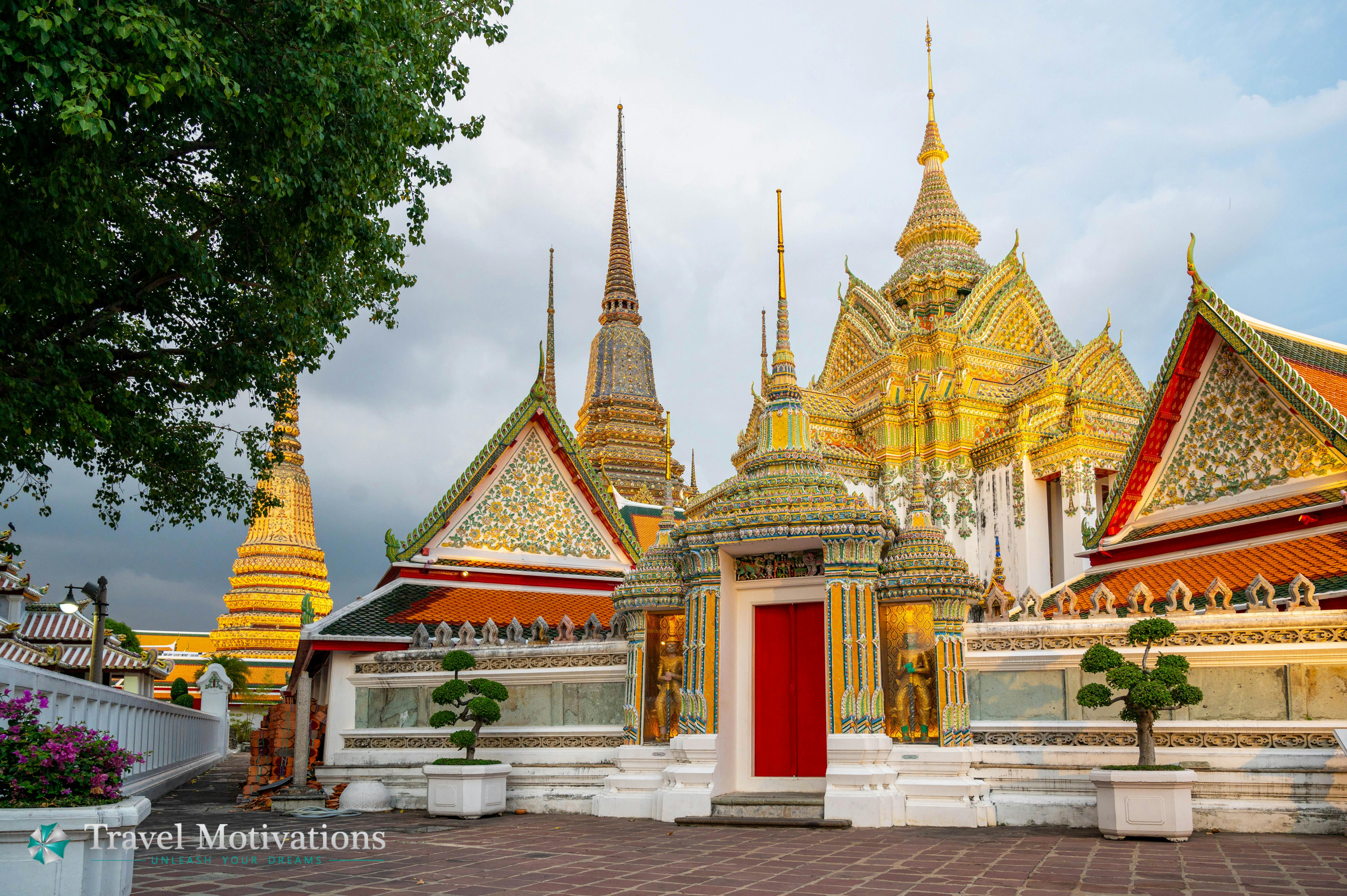There are more than 400 temples in Bangkok, good enough to give a tough time to any visitor to choose from. But few of these temples have the treasures that Wat Pho holds within its storied walls. For any visitor to Bangkok, it should be a priority on the list of places to visit.
As one of the largest and oldest temples in Bangkok, built by the founder of the city, it has been a bastion of the Buddhist faith as the modern metropolis has grown around it.
Wat Pho, officially known as Wat Phra Chetuphon Wimon Mangkhalaram Ratchaworamahawihan is a Buddhist temple complex in the Phra Nakhon district of Bangkok, Thailand. It is one of the six temples in Thailand that are of the highest grade of first class Royal temples. It is renowned as one of the city’s oldest and largest temple complexes and is particularly famous for housing the impressive Reclining Buddha statue.
Wat Pho is at the heart of the country’s royal district and the centre of Thailand’s faith. Both are extremely important. This is where they intersect with the city’s heritage.
The History of Wat Pho
The story of Wat Pho is older than that of Bangkok itself. Because, even before the city existed, there was a temple on this site. But by the time King Rama I founded Bangkok in 1782, it was basically in ruins. As it was right next to his royal palace he decided to rebuild it, and it became the main temple of the king. It was a huge project during the time, and a large part of it was about cementing Bangkok as the capital of the new kingdom. One of the ways that was done was by moving ancient Buddha statues here from the capitals of the previous kingdoms in Sukhothai and Ayutthaya. In the decades after that, Wat Pho continued to be an extremely important royal temple because of its proximity to the Grand Palace. Successive kings added their marks, expanding and renovating different parts, especially King Rama III during the first half of the 19th century. King Rama IV added a new stupa and made some minor changes in the second half of the 19th century, but since then there have been no major changes, although regular restoration work has taken place. The most recent large-scale restoration was in 1982.
The famous Reclining Buddha: The most famous idol at Wat Pho is the enormous Reclining Buddha statue, also known as Phra Buddha Saiyas. It is housed within the temple complex in its building, called Viharn Phranorn, which is decorated with murals inside.
The statue measures 46 meters in length and 15 meters in height, making it one of the largest reclining Buddha images in Thailand. The statue’s feet are adorned with intricate mother-of-pearl inlays. The feet of the Reclining Buddha statue are 5 meters long and decorated in laksana (Buddhist Sanskrit symbols & characters) of the Buddha. It depicts various symbols and auspicious characteristics of the Buddha.
The massive 46-meter-long reclining Buddha must be experienced in person as it is simply breathtaking. The amazing feeling of taking in the sight of the enormous golden figure of the ‘enlightened one’ cannot be explained with words. One has to experience the grandeur and massive-sized deity in person.
Along the side of the Buddha are 108 metal bowls which people can walk alongside and drop 108 coins into. People can buy all the coins they need for some bahts.
The Temple Complex: The Wat Pho complex is expansive and takes at least an hour to explore properly. The various structures hold artefacts and give the faithful opportunities to express their devotion. It is vast and covers an area of about 20 acres. It contains numerous structures, chapels, stupas, and courtyards. The temple’s architecture is a splendid example of traditional Thai design, featuring colourful tiles, ornate carvings, and intricate details. Wat Pho temple complex boasts the largest collection of Buddha images in Thailand and maintains the title as the country’s earliest centre for public education, specializing in religion, science and literature. Most of the Buddha images on display were brought to Wat Pho, by order of King Rama I, from abandoned temples in Ayutthaya and Sukhothai.
Other attractions at Wat Pho complex include:
- Four chapels – displaying 394 gilded Buddha images.
- Murals – Intricately detailed murals that cover the walkways around Wat Pho. They are so detailed and intricate that even if one does not understand all the imagery he can still appreciate the artwork.
- Courtyard – Chinese statues that were once used on ships and 91 Chedis (or Stupas) decorated in ceramic pottery flowers and colourful tiles. The
- The Bodhi tree is considered sacred in Buddhism. It is grown from a part of the real tree that Buddha sat under in meditation. The original tree is said to have grown from a cutting of the Bodhi tree in Bodh Gaya, India, under which the Buddha attained enlightenment.
Massage School: Wat Pho is associated with traditional Thai massage because the temple compound is also the national headquarters for the teaching and preservation of traditional Thai medicine, including Thai massage, a mandate legislated by Rama III when the tradition was in danger of extinction. Wat Pho is considered as the birthplace of traditional Thai massage. The temple houses a massage school where visitors can receive massages and learn the techniques of this ancient healing art.
It may seem strange to visit a temple and end up laying on a mattress and getting the muscles kneaded, but this is no ordinary massage experience.
Although it is more expensive than one would find out on the streets, this is a special opportunity to get a traditional massage from therapists trained in a temple, something that has been studied for decades and is an important part of Thailand’s culture, just like Wat Pho itself.
Guardians: The temple complex is guarded by stone statues known as “yakshas” or “giant demons.” These statues are placed at the entrances to protect the sacred space.
Chedis: There are numerous chedis (stupas) within the temple complex, each containing the ashes of Thai royals. The chedis are beautifully decorated with ceramics and colourful tiles.
Wat Pho is open to the public, and it is a popular destination for both tourists and locals. Visitors can explore the temple grounds, admire the architecture, and experience the spiritual and cultural significance of this historic site.
Things one should follow when visiting the Wat Pho:
- Respectful attire is required. Wat Pho is a functioning Thai Buddhist temple, and as such the management insists that visitors dress respectfully. The men must wear long pants and short-sleeved or long-sleeved shirts (no tank tops or sleeveless shirts). Women must wear skirts or pants extending at least to the knee, and also should not wear a top that reveals bare shoulders.
- Visitors are allowed to take photographs in any area of the complex.
- It is recommended that visitors wear shoes that can be easily removed as one would have to take them off when entering any structure in the complex.
It is wise to travel with a Luxury Concierge who can be the perfect Thai tour guide. This way visitor can enjoy a customised sightseeing tour suited to their tastes. A concierge luxury travel would help to have a guided tour through not only Wat Pho but also the Grand Palace which is an easy ten-minute walk away. They would also be able to provide VIP access to different areas of interest.
Conclusion
Wat Pho is not only a significant religious site but also a place of cultural and historical importance, offering a glimpse into Thailand’s rich heritage. It is located near the Grand Palace, making it a convenient stop for those exploring the historic heart of Bangkok.
Interesting Reads: What does the process of working with a travel advisor typically look like? Concierge Services in Medical Tourism in Thailand Business Concierge Services to help you grow your business Travel agent vs. Travel Concierge










